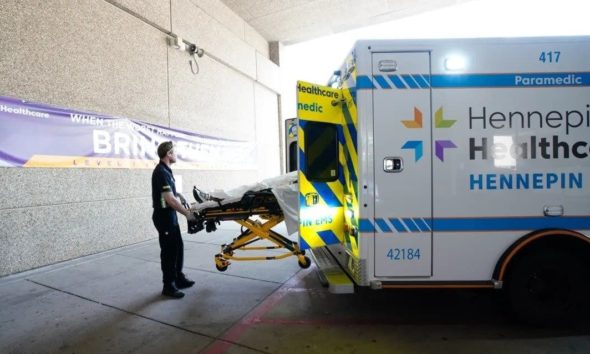Health
Minnesota overdose deaths held steady in 2022

Widespread naloxone availability is a key response to average of three deaths a day
Overdose deaths held steady from 2021 to 2022, 1,356 to 1,343, marking a plateau after several years of sharp increases, according to the Minnesota Department of Health’s (MDH) Statewide Trends in Drug Overdose: Preliminary 2022 Data Update (PDF). At the same time, the preliminary data showed fentanyl-related overdoses continued to take a tragic toll, keeping deaths at a historically high level.
Fentanyl, which is more deadly and 50 times more potent than heroin, has made Minnesota’s drug supply more dangerous. Fentanyl is now involved in 92% of all opioid-involved deaths and 62% of all overdose deaths in Minnesota, according to preliminary 2022 data. Opioid-involved deaths increased 3% (977 to 1002 deaths) from 2021 to 2022, according to preliminary data.
“We are responding to the more deadly threat of fentanyl with several new tools for saving lives that were passed by the Legislature in 2023, such as expanding the availability of naloxone, and covering the costs of having it on hand, in school buildings, treatment programs, and during emergency and law enforcement calls,” said Minnesota Commissioner of Health Dr. Brooke Cunningham.

Meanwhile, deaths involving prescribed opioids, heroin and methadone decreased. Deaths involving heroin fell to a 10-year low, decreasing 56% (103 to 45 deaths) between 2021 and 2022.
Psychostimulants (e.g., methamphetamine) and cocaine also contributed to the number of drug overdose deaths. Cocaine-involved deaths saw the largest increase of any drug category, increasing 27% (165 to 210 deaths).
Drug overdoses have a larger impact on individuals, families and communities than deaths alone. For every one drug overdose death, there were nearly 13 nonfatal drug overdoses in 2022. The number of hospital-treated nonfatal overdoses remained relatively stable, decreasing 5% from 2021 to 2022 (17,792 to 16,934 overdoses), according to the data brief.
Governor Tim Walz and Lieutenant Governor Peggy Flanagan’s 2023 One Minnesota Budget included over $200 million to address substance use and overdoses—with $50 million of that coming to MDH over the next four years. The investment addresses prevention, harm reduction, treatment and recovery. Additionally, the governor and Legislature passed a policy to reduce drug overdose deaths by requiring all schools, law enforcement officials, emergency responders and residential treatment programs to have naloxone on hand. MDH and the Minnesota Department of Education have posted a toolkit to help schools obtain cost-free naloxone and implement the new requirement.
Additional state-led activities include expanding medication-assisted treatment, establishing new peer recovery support systems and launching the MN Naloxone Portal where mandated groups can access no-cost naloxone. Collaboration with other state agencies and federal funding partners help make this overdose and substance use response work possible.
-MDH-
Health
E. coli O157 infections linked to consumption of burgers from Twin Cities restaurants

Health officials are urging people to contact their health care provider if they ate a hamburger, especially if undercooked, at a table-service restaurant since Oct. 31 and then developed diarrhea, particularly bloody diarrhea, in the following week.
The Minnesota Department of Health (MDH) has identified 10 cases of E. coli O157 infection in people who had eaten burgers at multiple locations of Red Cow, a table-service restaurant chain with locations in Hennepin, Ramsey and Olmsted counties. One additional case reported dining at Hen House Eatery in Minneapolis, which received the same ground beef product suspected in this investigation. The ground beef product was also distributed to other establishments, so additional cases from other locations could be identified.
So far, cases have reported meal dates of Oct. 31 through Nov. 7, and illness onset dates range from Nov. 4 through Nov. 9. Cases range in age from 9 to 70 years. Two cases have been hospitalized. Additional potential cases are under investigation.
Red Cow and Hen House Eatery owners are fully cooperating with the investigation and have made multiple changes, including product changes, to prevent further illnesses. MDH is working with the Minnesota Department of Agriculture and multiple local environmental health agencies during this ongoing investigation.
Symptoms of illness caused by E. coli O157 typically include stomach cramps and diarrhea, often with bloody stools, but only a low-grade or no fever. People typically become ill two to five days after exposure, but this period can range from one to eight days. Most people recover in five to 10 days. However, about 5% of E. coli O157 infections lead to hemolytic uremic syndrome (HUS), a severe complication that involves acute kidney failure and other severe problems. Treatment with fluids can help prevent HUS, but E. coli O157 gastroenteritis should not be treated with antibiotics, which can increase the likelihood of HUS.
Anyone who believes they may have developed an E. coli O157 infection should contact their health care provider.
Approximately 100 cases of E. coli O157 infection are reported each year in Minnesota. More information on E. coli O157 and how to prevent it can be found on the MDH E. coli website.
-MDH-
Health
Effects of Tobacco on Mental Health

Background
Historical development of the conversations regarding mental health have not been progressing as rapidly as one would prefer. We have gained greater knowledge about mental illness over the last 20 years, and the majority of us now believe that therapy works. But there’s a growing societal perception that those with mental illness are unpredictable and dangerous.Studies have indicated that smoking exacerbates stress and anxiety. Smokers believe smoking lowers stress and anxiety because nicotine instantly relaxes them. This sensation is fleeting and is quickly followed by cravings and withdrawal symptoms. Furthermore, there is a great deal of stigma attached to drug addiction problems, and people often blame those who are ill for their habits. Many people are hesitant to seek treatment or disclose their disease in public due to these misconceptions and biases.
Understanding the Chemical Effect
Dopamine is released in the brain in response to stimulation by nicotine. Dopamine has a role in eliciting happy emotions. People with depression frequently have low levels of it, and as a result, they may smoke cigarettes to momentarily boost their dopamine levels. Smoking, however, causes the brain to turn off the process by which it produces dopamine, which eventually results in a decrease in supply and an increase in smoking.When trying to quit smoking, people with depression may find it very difficult and have more acute withdrawal symptoms. Never forget that if you want to stop, there is a ton of help available. You don’t have to experience it alone, though.
Coping and Seeking Help
Avoid isolating yourself. It’s possible that you’re reluctant to disclose your mental health condition to others. If your loved ones, friends, clergy, or neighbors are aware of your mental health condition, they can help you. Seek the empathy, understanding, and support you require from those you can trust. There is a misplaced stigma in the East African community when it comes to mental illness. However, this should not stop one from seeking the help they need.
Support from friends and family might make quitting smoking easier. Encourage your friends or cohabitants who smoke to quit smoking if you live with them. Even for people who have managed to abstain from smoking for more than a year, having a mental illness at the time of quitting increases the likelihood of relapsing into smoking. For the same reasons that others have mentioned (health and family), many smokers with mental illnesses wish to stop, but they may be more susceptible to relapse due to stress and other unpleasant emotions.
Article by WellShare International
Health
What is Vaping?

Vaping is a new tobacco product that has taken our community by storm. People can come across it everywhere, from schools to our community centers. It seems to be more and more accepted in society and is quickly becoming a fad that the youth want to partake in. It would almost seem out of the ordinary to not have encountered a vaping product due its rapidly increasing popularity amongst youth.
E-cigarettes are devices that use heat to create an aerosol that is inhaled by the user. Typically, the liquid contains flavoring, nicotine, and other chemicals. Just like traditional cigarettes, e-cigarettes contain addictive nicotine. Because nicotine is present in the majority of e-cigarettes, they are classified as tobacco products and considered just as addictive as cigarettes.
The teenage years are a critical period for brain development. Brain development starts in the womb throughout the fetus’s growth and continues throughout childhood until roughly 25. Exposure to nicotine in adolescence and early adulthood can damage the growing brain and lead to addiction.
Many of our youth are currently using these products due to the misinformed belief that it is not harmful. Some youth also believe that it is not a tobacco product and is not detrimental to their health like cigarettes or other tobacco products. Young folks are big fans of e-cigarettes because of their discreet design. Over the past five years, their use has increased significantly. E-cigarettes are becoming more popular among high school students than traditional smoking. Adults are less likely than high school students to use e-cigarettes.
What can we do
The biggest problem adults and parents are facing when it comes to their youth vaping is that they don’t know enough about the practice and the products themselves. The best way to address this problem is to bring awareness to the issue and provide them with the basic information they need to combat this vaping problem amongst our youth. Educating ourselves includes knowing what vaping products look like, feel like, and the dangers associated with them.
While the biggest problem adults are facing with vaping is a lack of awareness, it is the complete opposite for the youth. Ever since vaping gained popularity some years ago, it has increasingly become more of a stable product amongst the younger crowd. It would almost seem that it is a trend that everyone must participate in and if not, one would feel as if they are either missing out or being judged by their peers. Peer pressure often results in youth succumbing to the trend in an attempt to fit in with their peers.
If you find yourself feeling pressured or bullied into vaping in order to please your friends, that would be a good sign that you may need to find a new group of friends. True friends would want the best for you and respect your decisions and values. If these sentiments are not being provided by your current group of friends, cutting ties with them may be a healthier route.
What resources are available for people who are using:
For Minnesotans who are using tobacco products, QuitPartner is a free resource that will help guide you through each step of the quitting and recovery process. Counselors are available for both youth and adults. The service can be anonymous. Here is the contact information for QuitPartner: Website: Quitpartnermn.com, 1-800-QUIT-NOW (784-8669)
-

 Local News6 months ago
Local News6 months agoGovernor Walz Announces Minnesota Ranked as a Top State for Business
-

 Local News3 months ago
Local News3 months agoCelebrating Community: The Inaugural Samafal Gala at the Minnesota Somali Community Center
-

 Community4 months ago
Community4 months agoYouth Leader and Mentor: Mohamed Jama’s Fight for Change in Whittier
-

 Local News6 months ago
Local News6 months agoSecretary Simon Named President of the National Association of Secretaries of State
-

 Local News4 months ago
Local News4 months agoBCA Identifies man shot by Minneapolis police after firing AK-47 in Minneapolis apartment building
-

 Videos3 months ago
Videos3 months agoContracting: Mastering the Basics and Beyond – Nov 13th
-

 Local News3 months ago
Local News3 months agoDuqa magaaladda Minneapolis Jacob Frey ayaa qorsheynaya inuu mar kale isu soo taago doorashada Duqa Magaaladda
-

 Local News3 months ago
Local News3 months agoNINKII SHANTA GABDHOOD SHILKA KU DILAY OO DIIDAY HESHIIS QIRASHO AH, GO’AANSADAYNA IN MAXKAMAD LA HORGEEYO

